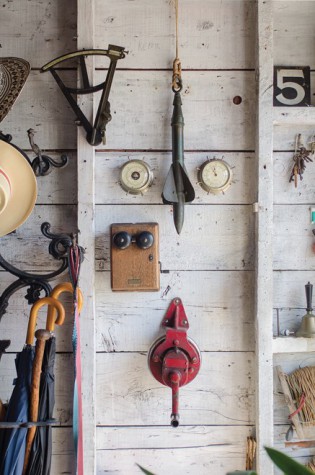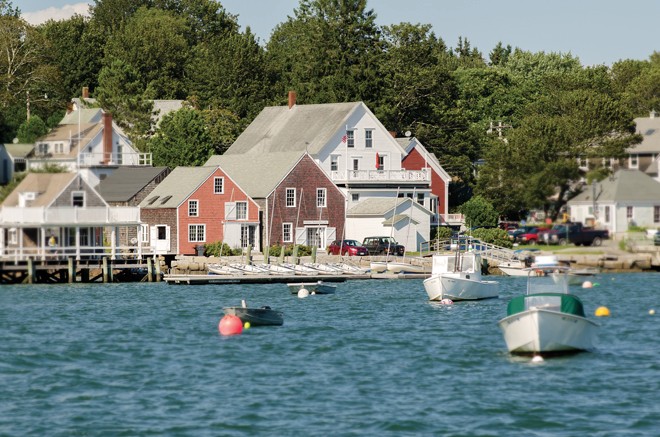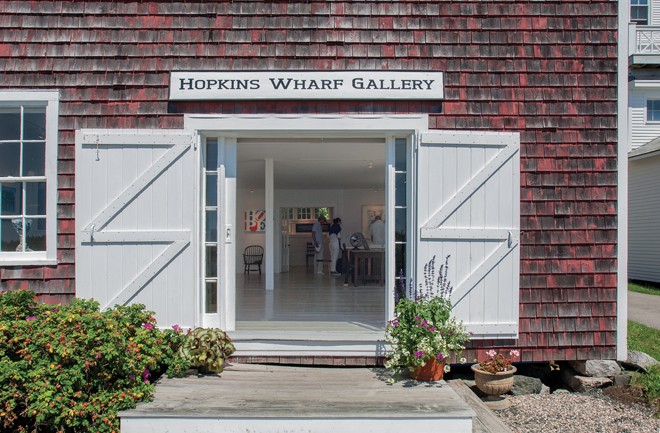North Haven Archive
FEATURE
A couple celebrates family history and local art in their home and gallery
Does everyone on the island of North Haven know David Hopkins? “Oh, yes, my God, yes,” Hopkins says. If you had asked the question of his father or his great-grandfather, they might have answered similarly. Hopkins estimates that he is related to two-thirds of the approximately 340 people who live year-round on North Haven. A favorite island parlor game? Name two island residents and then figure out how they are related. But even summer visitors might encounter Hopkins and David Wilson, who is an artist and Hopkins’s partner of 36 years. After all, the first thing one sees when one steps off the North Haven ferry are two wharf structures, one a gallery run by Hopkins and Wilson, the other their home. A 30-second walk takes one up to Main Street, where Hopkins’s mother, June, has a many-roomed gift shop and her own gallery. The small parcel of land on which these (and other) buildings cluster once belonged to Hopkins’s great-grandfather, W.S. Hopkins. He ran a successful general store on the property. “At that time the [Fox Island] Thorofare was like Route 1,” Hopkins says. “The boats from Boston to Bar Harbor would stop and get provisions from the store. It was really quite a going concern with all these different buildings geared for grain or ice or fish or wood or coal or what have you.”
After the death of W.S. Hopkins in 1945, the family decided to sell the business. A group of summer people invested in the grocery store, but when it went bankrupt, they decided to donate the buildings to the Knox County General Hospital (what is now Pen Bay Medical Center) with the idea that the hospital could benefit from the proceeds of the sale.
Enter Hopkins’s mother and father, who had decided to move to North Haven with their three children. (Hopkins’s father had been hired as the principal of the island school.) “They thought it would be a great idea to get the property back in the family. They made an offer and the hospital accepted,” says Hopkins.
In 1954 the family moved in, and June decided to open her gift shop. (She runs it to this day. In fact, this summer, many months after June turns 90, the shop will have its 60th anniversary.) Meanwhile Hopkins’s father found a tenant for the grocery store, then opened a fish market and began running a marina. Explaining how his father managed this while also being the school principal (and later a real estate agent, teacher of creative writing in a prison, and more), Hopkins says, “On an island, you have to wear a lot of different hats to get by.” Even with the revived businesses, there were still empty buildings on the wharf complex where Hopkins and his brothers played.
“When my brother Eric was 16 and I was 14,” Hopkins says, “we thought it would be fun to open an art gallery.” So they did, showing work in “the carriage house,” which is now the structure in which “the Davids,” as friends call them, live. Hopkins ran the gallery through college, where he’d gone to study museology, but afterward he had to make a choice. “There weren’t any museums on North Haven, and I liked island life, so I moved to Manhattan,” he quips. He took a job at the Metropolitan Museum of Art, where he worked in merchandising and retail for over 30 years. Meanwhile, his gallery didn’t disappear. His mother took part of it to Main Street and renamed it North Haven Gallery, and brother Eric started his own gallery, Eric Hopkins Gallery, which featured his own work: colorful, swirling images of land, sea, and sky, now so famous that they are in virtually every museum in Maine as well as private and public collections around the world.
Fast-forward three decades: Eric decides to move his gallery to Rockland, and Hopkins and Wilson return to North Haven to take over Eric’s gallery, which they rename Hopkins Wharf Gallery. The gallery shows the work of Eric Hopkins and David Wilson, but also of other artists with North Haven connections, such as Hopkins’s cousin Paul, who makes fish sculptures and goose decoys; Amy Peters Wood, a longtime summer resident; and Sam and Chris Minot, who spent part of their childhood summers in the house next door to where Hopkins and Wilson live. These artists and others take island or coastal life as their subject but work it in very different ways. William Steiger, whose wife has summered on the island, makes Penobscot Bay collages using nautical charts. (Some of the work depicts Hopkins and Wilson’s gallery and home.) Herbert Parsons paints long, horizontal, realistic landscapes. As for David Wilson, whose studio is above the gallery: he is Scottish, although he’s lived in the States for 37 years, and his work frequently features the silhouette of a tree, a vertical, almost heraldic, image, which suggests nature but also an upright figure. More recently, Wilson has been working on large-scale pieces that make use of repeated images of a single leaf. While in New York, Wilson also worked as a decorative wall painter. On North Haven his wall finishes can be seen at Nebo Lodge, a nearby inn, which features rugs, quilts, and wallpaper by Angela Adams, another North Haven native. In addition, Wilson has painted a mural on the dining room walls of Nebo Lodge’s celebrated restaurant. Here, Wilson’s seascape pays homage to yet another artist shown at Hopkins Wharf Gallery: Frank Benson, an American impressionist who summered in North Haven for the first half of the twentieth century, and who painted similar scenes on the walls of his own home.
During the summer Hopkins and Wilson keep the barn doors to their home open, and sometimes strangers wander in, pick up an item from a shelf, and ask the price. Hopkins and Wilson have to kindly redirect them: “Actually, the gallery is next door.” Still, it’s easy to see why a visitor might want to shop in Hopkins and Wilson’s kitchen and living room. Though modest—an uninsulated, open-stud building built with one room downstairs and one room up—it’s an eclectic, funky space full of treasures, which include a mix of island finds, family heirlooms, presents from friends, pieces that Hopkins acquired from the Metropolitan’s gift shop, and more.
“I not only know everyone on the island,” Hopkins says. “I know everything left at the dump.” Among the discarded items he’s rescued: a hat rack, an orange sofa, an old piece of orange and white checkerboard linoleum from his great-uncle’s house, an old kitchen table, and old wooden chairs. A partial row of wooden movie theater seats comes from Calderwood Hall, which was built by Hopkins’s great-great-aunt and great-great-uncle as a dance hall and movie theater. Other treasures weren’t discarded but inherited. These include the keys to the original family house, a fire horn from a relative’s farm, a sextant, and a ship’s log box from Hopkins’s great-great-grandfather. The log box went around Cape Horn twice. (When Hopkins was traveling for the Met, he used the box for his frequent-flier documents.)
It’s not just Hopkins’s family heirlooms that fill the house. Wilson’s grandmother’s clock hangs on one wall. “My grandmother was pretty modest in her means but very house proud,” says Wilson. “She probably bought the clock from the Cooperative Wholesale Society back home. The clock was so well maintained and highly polished that at one time she took off the blacking on the numerals and painted them back in. I like it because of that.” Wilson’s great-grandfather, grandfather, and mother were all painters, and some of their work hangs above a dresser on which rests a medal that Wilson’s great-grandfather won at an art competition. Of his grandfather, Wilson says, “I always remember he taught me to draw a straight line freehand. I must have been five or six. It gave me the confidence to actually draw.” As for items that are reproductions from the Met: many pieces are blue and white, including a thigh-high vase that sits on the floor, china, and picnic plates made of tin so they can’t be broken.
Because the visual enticements of Hopkins and Wilson’s home and gallery are always coupled with a narrative, there is pleasure to be had in learning what life on an island is like, especially this island, which mixes summer money, a density of artistic talent, family intimacy, and year-round, hardscrabble work. One doesn’t even need to step off the wharf to encounter all this, since Hopkins and Wilson’s home and gallery are built on pilings over the water. At one point, Hopkins and his brothers used to jig for eels through a trapdoor underneath the kitchen table, but the trapdoor disappeared when the home was jacked up and new floors were installed after a flood. Ever true to his and Hopkins’s desire to honor their origins, Wilson says of the trapdoor, “I am tempted to put it back.”







































